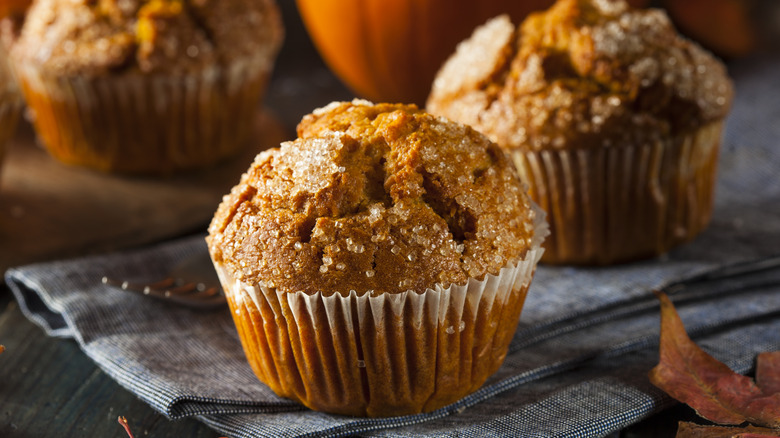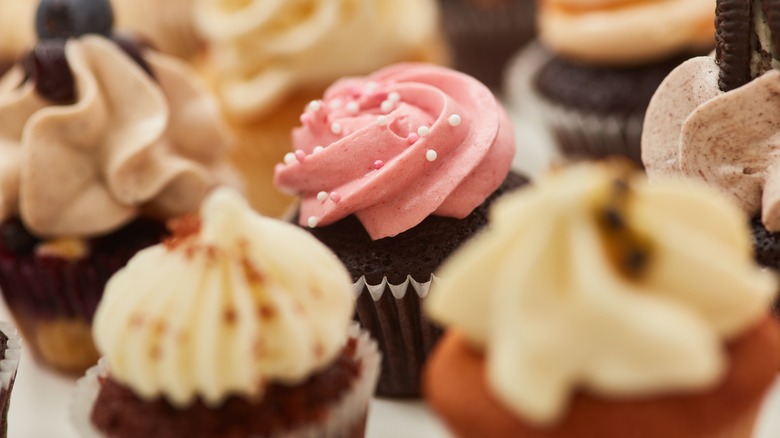What's The Difference Between A Cupcake And A Muffin?
Cupcakes and muffins are two of the most universally beloved baked goods of our time. As BBC News Magazine reported back in 2009, the cupcake enjoyed a meteoric rise in the late 2000s and early 2010s, bolstered by appearances on cultural touchstones like "Sex and the City." Cupcake shops sprung up on street corners all around the world, boasting sugary creations of all hues and flavors. Food tycoons like Martha Stewart released cupcake-centric cookbooks. One cupcake shop, Washington D.C.'s Georgetown Cupcake, even got its own reality show. But the humble muffin didn't fade into the background during this renaissance. That less-flashy breakfast classic chugged along, as beloved as ever, even as cupcake mania cooled.
Nowadays, cupcakes and muffins exist in harmony. It's safe to say that most people who love one also love the other, as they're remarkably similar in a number of ways. They're both baked in the same sort of pan, they both have the same general shape, and they both feature many of the same ingredients. They're so similar, in fact, that they prompt a question: What's the actual difference between cupcakes and muffins? Does a difference even exist, in a world full of chocolate-chip muffins covered in vanilla glaze? There is indeed a difference between these two baked goods — but the truth is a little more complicated than you might expect.
The difference between quick breads and cakes
The most important distinction between cupcakes and muffins is simple: Muffins are considered quick breads, while cupcakes are — you guessed it — cakes. What are quick breads, exactly? Quick breads are breads that use a chemical leavener like baking soda or baking powder to rise, rather than time-consuming yeast. Typically, they contain flour, sugar, and some sort of fat, like butter or vegetable oil. Sounds kind of like cake, doesn't it? The distinction can indeed be a fine one: As celebrated baker Alice Medrich noted for Food52, many quick breads really are just cakes in everything but name. Baked goods like brioche blur the line between bread and cake even more dramatically.
This doesn't mean a distinction doesn't exist, however. Quick breads like muffins tend to use less sugar, and rarely incorporate cake flour. In fact, they often use whole wheat flour, nut flour, or oats — ingredients you rarely see in cake recipes. They also typically feature a coarser crumb and a denser texture. You'll probably never see a "chiffon muffin" for sale, for example, but chiffon cakes are a beloved staple of the dessert table. This sturdiness is what enables the muffin to have a distinct "top," which cupcakes lack. Such robust structure is a big part of what defines quick breads as their own category, and muffins as separate from cupcakes.
Cupcakes and muffins in culture
Muffins and cupcakes are principally separated by the former's status as a quick bread. But beyond this major difference lie many other, albeit smaller, ones. These distinctions are fuzzier and often arbitrary, but they're just as important. Most of them boil down to a simple fact: Cupcakes and muffins are different because we treat them as such.
When one ponders the difference between muffins and cupcakes, as a columnist for the Herald-Tribune did in 2017, one often thinks of frosting. Cupcakes have it, muffins don't. But there's no scientific reason muffins couldn't have frosting. Many muffins would probably be pretty tasty when paired with fluffy buttercream, in fact, and plenty of muffins flirt with frosting by incorporating sweet glazes. But, by and large, we don't put proper frosting on muffins. Similarly, muffins often feature savory ingredients like cheddar cheese, jalapeños, bacon, and scallions, which cupcakes avoid. There's no set-in-stone rule forbidding cupcakes from using these foodstuffs. In fact, some cupcakes use similarly savory ingredients, like peanut butter and potato chips. But, generally speaking, people don't put things like jalapeños or scallions in their cupcakes. In following these cultural norms, we make muffins and cupcakes distinct. Innovative chefs of the future might turn out bacon-studded cupcakes and fondant-laden muffins, but until then, muffins and cupcakes remain separate entities.


